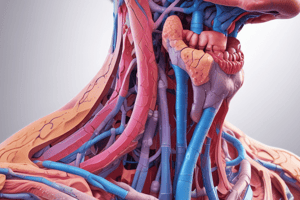Podcast
Questions and Answers
What is the most common presentation of a thyroglossal duct cyst?
What is the most common presentation of a thyroglossal duct cyst?
- A hard, fixed mass in the lateral neck
- An inflamed lymph node
- A cystic midline swelling (correct)
- A submental dermoid cyst
How does a thyroglossal duct cyst behave during tongue protrusion?
How does a thyroglossal duct cyst behave during tongue protrusion?
- It remains stationary
- It moves towards the floor of the mouth
- It moves with the tongue (correct)
- It becomes less visible
Which of the following conditions does NOT typically present as a midline swelling?
Which of the following conditions does NOT typically present as a midline swelling?
- Ludwig’s angina
- Submental lymphadenopathy (correct)
- Thyroglossal duct cyst
- Sublingual dermoid cyst
What is the primary treatment for a thyroglossal duct cyst?
What is the primary treatment for a thyroglossal duct cyst?
Which group of nodes drains the larynx and trachea?
Which group of nodes drains the larynx and trachea?
What distinguishes a sublingual dermoid cyst from a thyroglossal duct cyst?
What distinguishes a sublingual dermoid cyst from a thyroglossal duct cyst?
In the case of enlarged submental nodes, what should be particularly investigated?
In the case of enlarged submental nodes, what should be particularly investigated?
What can occur if a thyroglossal duct cyst undergoes rupture from infection?
What can occur if a thyroglossal duct cyst undergoes rupture from infection?
What is the most common presentation of a thymic cyst?
What is the most common presentation of a thymic cyst?
At what age is the thymic cyst most commonly diagnosed?
At what age is the thymic cyst most commonly diagnosed?
Which condition is often associated with anomalies of the second branchial arch?
Which condition is often associated with anomalies of the second branchial arch?
What is the appropriate treatment for a thymic cyst?
What is the appropriate treatment for a thymic cyst?
Which presentation might indicate an upper respiratory infection in a thymic cyst?
Which presentation might indicate an upper respiratory infection in a thymic cyst?
What feature distinguishes a branchial cyst from other neck masses?
What feature distinguishes a branchial cyst from other neck masses?
What is a common characteristic of a thyroglossal cyst?
What is a common characteristic of a thyroglossal cyst?
In which region of the neck does a thymic cyst typically present?
In which region of the neck does a thymic cyst typically present?
Flashcards are hidden until you start studying
Study Notes
Overview of Neck Masses
- Neck masses can be classified into midline and lateral masses.
- Lateral masses can be categorized based on the neck's anatomical triangles.
Thyroglossal Duct Cyst
- Commonly presents as a cystic midline swelling in young children, with possible occurrence at any age.
- Typically rounded, measuring 2–4 cm in diameter, and may enlarge during upper respiratory infections.
- If infected, may drain through a sinus or require surgical drainage.
- Moves with tongue protrusion due to attachment to the foramen caecum at the base of the tongue.
- Originates from thyroid’s developmental pathway, which moves from the foramen caecum to form the thyroid gland.
- Can contain functioning thyroid tissue; rare cases of carcinoma possible.
Sublingual Dermoid Cyst
- Appears as a midline submental swelling that does not move with tongue protrusion.
- May arise from the floor of the mouth and needs differentiation from ranula.
- Surgical excision is the treatment approach.
Submental Nodes
- Located in the submental triangle between the platysma and mylohyoid muscle.
- Drainage area includes chin, middle lower lip, incisor region of gingiva, anterior floor of mouth, and tip of tongue.
- Enlargement prompts investigation for potential infections or malignancy.
Prelaryngeal and Pretracheal Nodes
- Requires complete surgical excision which includes the hyoid bone and surrounding tissues (Sistrunk’s operation) due to risk of recurrence.
- Part of the juxtavisceral lymphatic chain, located anterior to the larynx and trachea.
- Drain areas such as larynx, trachea, thyroid isthmus, and anteromedial thyroid lobes.
- Enlarged nodes require examination of draining areas.
Thymic Cyst
- Develops from the third pharyngeal pouch; can be cystic or solid.
- Appears as a neck mass located anterior and deep to the middle third of the sternocleidomastoid muscle.
- Rare condition, can occur at any age, often in the second decade, with equal prevalence in sexes.
- Treatment is surgical excision; sternotomy may be required if extending to the mediastinum.
Branchial Cyst
- Arises from anomalies of the second branchial arch.
- Typically presents as a mass in the upper neck near the sternocleidomastoid muscle.
- Masses are smooth, round, fluctuant, nontender, and may become painful during upper respiratory infections.
Additional Lateral Masses
- Includes various conditions such as:
- Submandibular sialadenitis or tumors.
- Metastatic lymph nodes from infraclavicular cancers.
- Parapharyngeal tumors, laryngocele, and pharyngeal pouch.
- Metastasis may indicate underlying malignancies from breast, lung, gastrointestinal tract, kidneys, or reproductive organs.
Important Anatomical Triangles
- Lateral neck masses can be classified into several triangles: anterior (with digastric, carotid, and muscular subdivisions), occipital triangle, supraclavicular triangle.
- Each triangle has its own potential pathologies and drainage patterns, requiring clinical assessment and management.
Studying That Suits You
Use AI to generate personalized quizzes and flashcards to suit your learning preferences.





